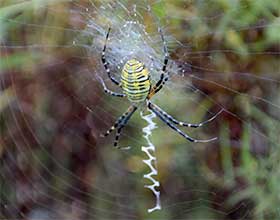 It’s probably fair to say that, despite our fondness and admiration for the title character from Charlotte’s Web, most people are happy to keep spiders at a distance for most of the year. But now it’s October, and, for a little while, houses and yards are decorated with spiders and their webs. The classic Halloween spider is long-legged and sits in a radiating web. Out in the local fields and meadows, the spiders that best exemplify that form are the garden spiders in the genus Argiope.
It’s probably fair to say that, despite our fondness and admiration for the title character from Charlotte’s Web, most people are happy to keep spiders at a distance for most of the year. But now it’s October, and, for a little while, houses and yards are decorated with spiders and their webs. The classic Halloween spider is long-legged and sits in a radiating web. Out in the local fields and meadows, the spiders that best exemplify that form are the garden spiders in the genus Argiope.
Two species of Argiope call our area home. The yellow garden spider, Argiope aurantia, has a black central band down its dorsal (upper) surface, with yellow bands extending down the animal’s sides. In contrast, the banded garden spider, Argiope trifasciata, has narrow white, black, and yellow stripes running laterally across the entire dorsum. Other differences include the coloration on the legs (more banded in trifasicata) and the darker underside of aurantia. The two species seem to be roughly equally common.
Two features of Argiope spiders immediately impress. The first is their size. These are among Ohio’s largest spiders, with leg spans up to about three inches (5 cm). Females are larger than males, so it’s the girl spiders that are most likely to trigger arachnophobia!
The second impressive feature is the silken web, which is an engineering marvel. Argiope webs, with their classic spoked-wheel pattern, can span 60 cm (2 ft) or more. Spider silks (spidroins) are proteins, encoded by a diversified set of genes. They are produced as a liquid emulsion in specialized abdominal glands, then extruded through valved spinnerets. That extrusion process concentrates the spidroins, which induces the proteins’ amino acids to align and form a fiber.
Argiope spiders generate seven varieties of silk, each from a separate gland and with properties corresponding to its uses. For example, the silk from the major ampulla gland is used to construct the framework of the web and to attach it to supports like stems and branches; it is strong (high tensile strength) but relatively non-extendible. In contrast, the web strands used for prey capture are stretchier and stickier; they derive from two glands, the flagelliform gland that produces a fibrous thread for weaving the capture spiral and the aggregate gland that produces a sticky liquid coating.
In the center of the Argiope web is an obvious variation in weaving pattern, a dense zig-zag element called a stabilimentum and structured from “actiniform” silk. Theories abound about the function of this structure. It may reflect ultraviolet light in a way that attracts potential prey items; it may provide visibility to birds so that they can avoid the web; it may even make the spider appear larger so that potential predators are deterred. Those possibilities are not mutually exclusive.
Once an insect is trapped in the sticky strands of the web, the process of subduing it begins. Garden spiders have a relatively poor visual sense, and so they locate ensnared prey primarily by sensing web vibrations. Sensitive sensory structures (lyriform organs and trichobothria), primarily on the legs, help to identify the size and location of the prey item, and to distinguish ensnared insects from disturbances like wind gusts. Upon detection, the spider rushes to the insect and injects a combination of paralytic toxin (to subdue movement that might damage the web) and digestive enzymes (so that the spider can eventually “drink” its liquified prey).
Spiders often store their prey items while the digestive enzymes take effect. To facilitate that storage, the spider wraps the captured insect in silk derived from the actiniform gland, the same as used for the stabilimentum. Several strands are extruded simultaneously, and the spider uses its front legs and limb-like pedipalps near the mouth to wrap the silk around the prey, forming a tight cocoon.
Adult Argope spiders do not survive the winter. As well described in Charlotte’s Web, female Argiope spiders die after laying their eggs, typically around the time of the first hard frost. So, just as Halloween spider decorations are disappearing from homes, so too adult garden spiders are disappearing from the landscape. But the next generation is ready to go. The eggs are encased by a cocoon (also spun from silk, of two varieties), and they hatch in late fall. The spiderlings don’t emerge from the cocoon until the following spring, though. The newly hatched Argiopes climb to a tall perch, toss a fine silk line into the breeze, and float off to a new home. Garden spiders and their spiderling babies might not be quite as endearing as the characters in E.B. White’s story–but surely they are worth celebrating with a greeting. Salutations!
Article and photo contributed by Dr. David L. Goldstein, Emeritus Professor, Department of Biological Sciences, Wright State University.
